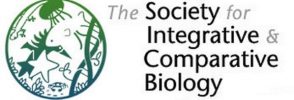Contents
- Division of Comparative Biomechanics: Spring Newsletter 2020
- Message from the Chair, Stacey Combes, Chair.DCB@sicb.org
- Message from the Program Officer, Matt McHenry, DPO.DCB@sicb.org
- Message from the Secretary, Emily Kane Secretary.DCB@sicb.org
- Message from the Student and Postdoctoral Representative, Armita Manafzadeh
- DCB Chair-Elect Candidate Biographies
Division of Comparative Biomechanics: Spring Newsletter 2020
Please vote in the Spring 2020 Elections (candidate biographies can be found below). The deadline is April 19th, and the ballot can be found in the link provided here. http://burkclients.com/sicb/elections/2020.php
Message from the Chair, Stacey Combes, Chair.DCB@sicb.org
The Division of Comparative Biomechanics came together at this year’s SICB meeting in Austin for a huge range of biomechanics-related symposia and contributed sessions, as well as a wonderful student-paper competition – see the Message from the Program Officer below for a summary of all of the DCB-related activities at the Austin meeting. This year, we gratefully acknowledge all of the hard work and dedication of our outgoing DCB officers: Secretary Sandy Kawano, Program Officer Phil Anderson, and Student/Postdoctoral Representative Brett Aiello. We are happy to welcome our new Secretary Emily Kane, Program Officer Matt McHenry and Student/Postdoctoral Representative Armita Manafzadeh, who will join Chair-Elect John Long and I in leading the Division of Comparative Biomechanics this year.
Congratulations to the DCB Best Student Presentation Award winners! The best student presentation competition offered a remarkable glimpse into the up-and-coming research of the graduate students in our division. Finalists were chosen from a larger pool of students who submitted extended abstracts in September, and all of the finalists presented fascinating work. We would like to thank Phil Anderson the DCB BSP committee for their impeccable organization and the time they dedicated to this year’s competition. We are already looking forward to hearing from next year’s new talent.
-
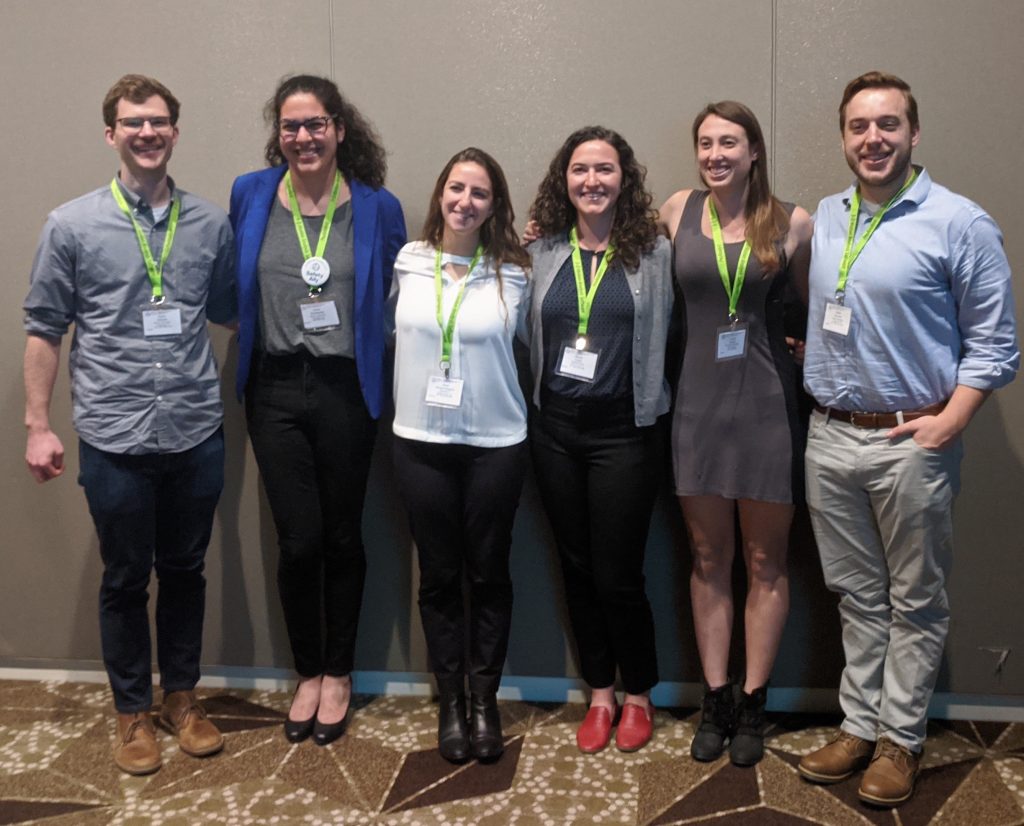
Best Student Oral Presentation Finalists
This year’s winners are:
- Winner of The Mimi A. R. Koehl and Stephen A. Wainwright Award for the Best Student Talk in Biomechanics: Rachel Crane, Stanford University, “Resistance and Repair of Mechanical Fatigue in Mussel Shells”
- Winner of The Steven Vogel Award for the Best Student Poster in Biomechanics: Samantha Smith, University of Texas Austin, “An Intralaryngeal Whistle Using an Elaborated Structure Enables Song in Alston’s Singing Mouse”
- Honorable Mention for The Mimi A. R. Koehl and Stephen A. Wainwright Award for the Best Student Talk in Biomechanics: David Sleboda, Brown University, “The Hydrostatic Skeleton of Muscle”
-
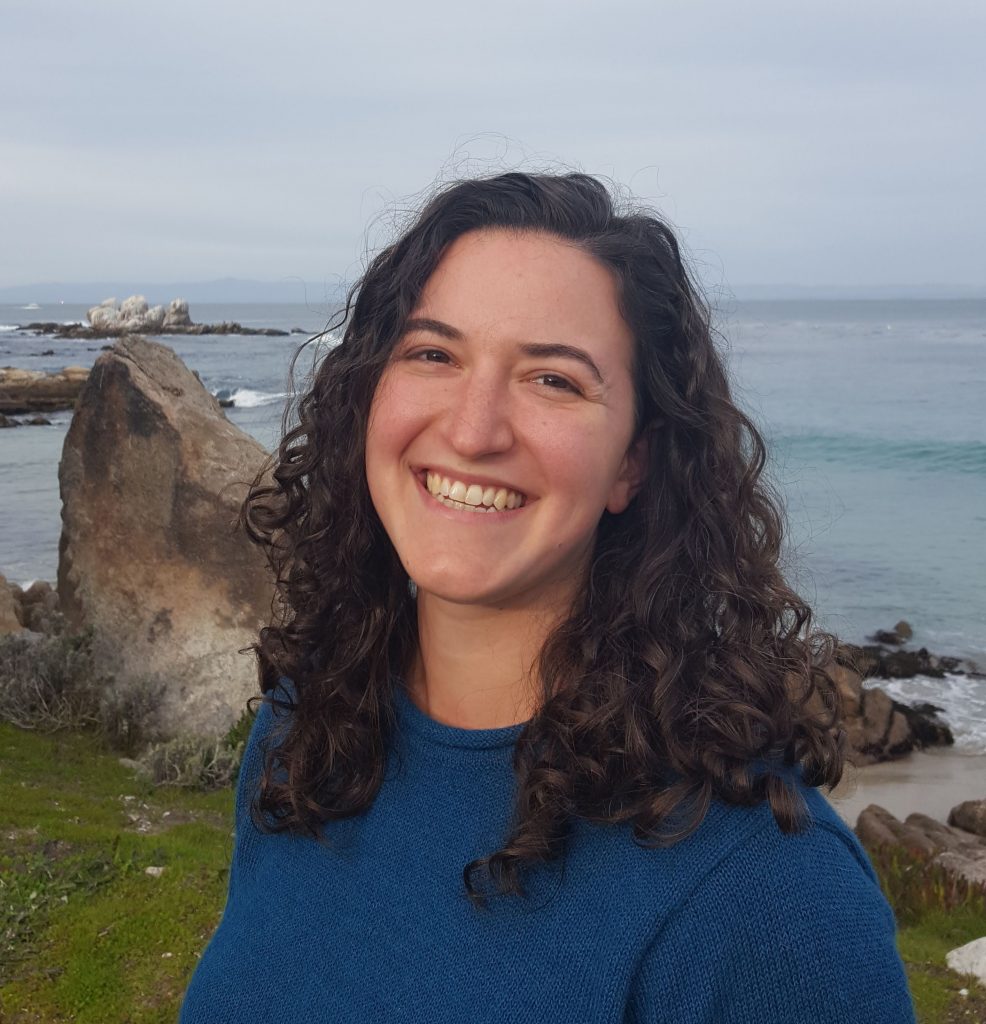
Rachel Crane -
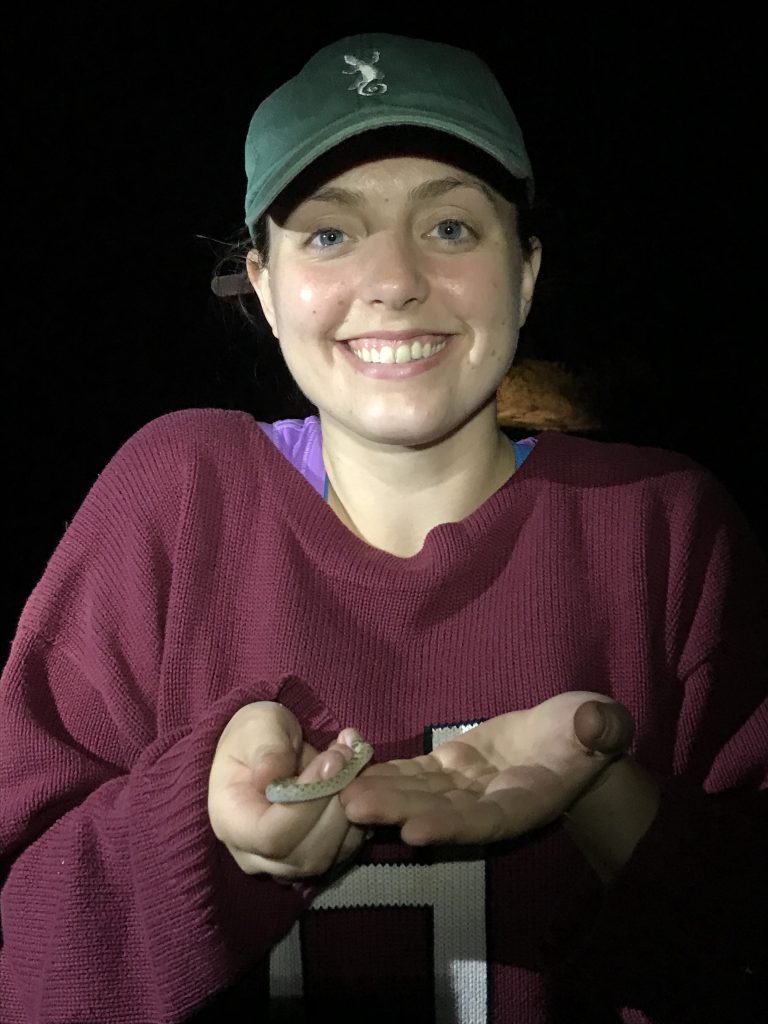
Samantha Smith -
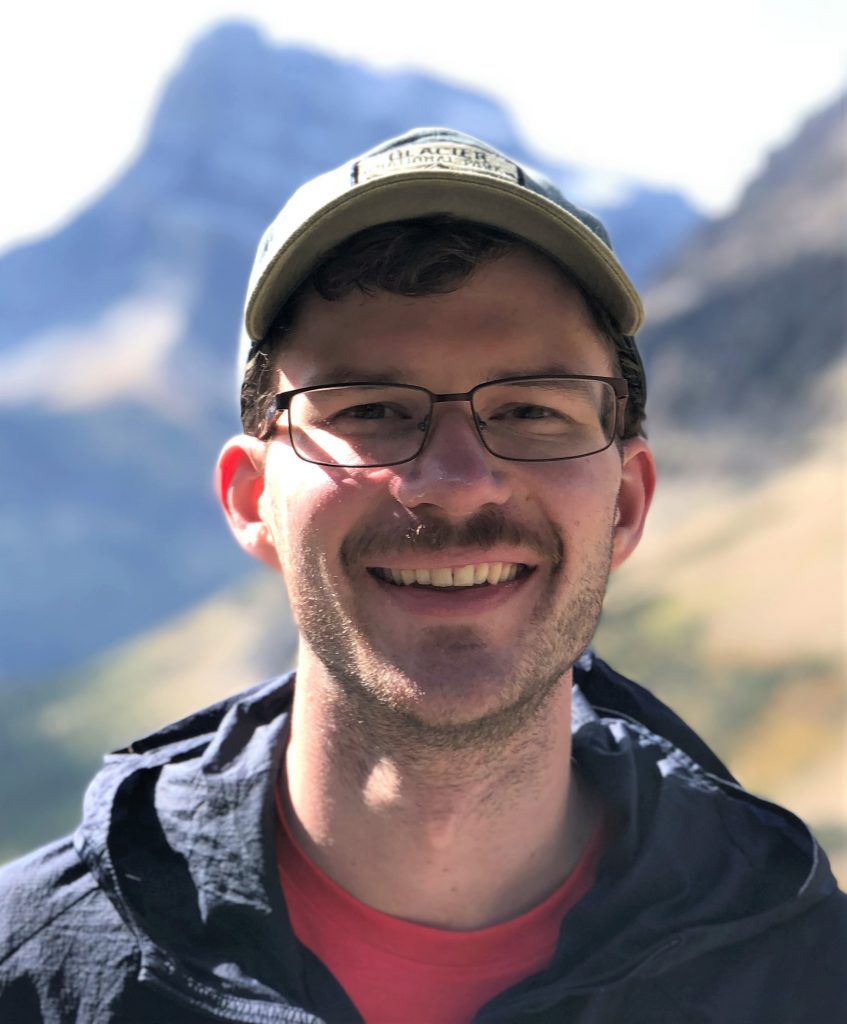
David Sleboda
Carl Gans Award. Each year, DCB evaluates applications for the Carl Gans Award, which was established to recognize Carl Gans’ contributions to animal morphology, biomechanics, and functional biology. This year for the first time, we had the opportunity to hear a half-hour keynote talk by the Gans Award Winner, Alyssa Stark, at the end of the DCB BSP session. Alyssa’s talk, Tenacious Toes and Fastening Feet: Biological Adhesive Systems in Complex Environments, exemplified the outstanding, comparative biomechanics research being done by young, rising stars within our division. The Gans Award is given to 1) an outstanding young investigator in the field of comparative biomechanics and/or 2) an investigator at any career stage for a significant contribution to the literature of comparative biomechanics published in the preceding five calendar years. The awardee receives a commemorative plaque at SICB, reimbursement for travel expenses to the meeting, and the honor of joining the ranks of past Carl Gans Awardees, such as Alyssa Stark, Misty Paig-Tran, Brooke Flammang, Sharlene Santana, Chris Clark, and Eric Tytell. We would love to see more members of our growing, vibrant DCB community included in the nominee pool for this award, so please think about submitting an application or nominating one of your colleagues! Additional details about the Gans award are available at: http://sicb.org/membership/awards.php3#gans.
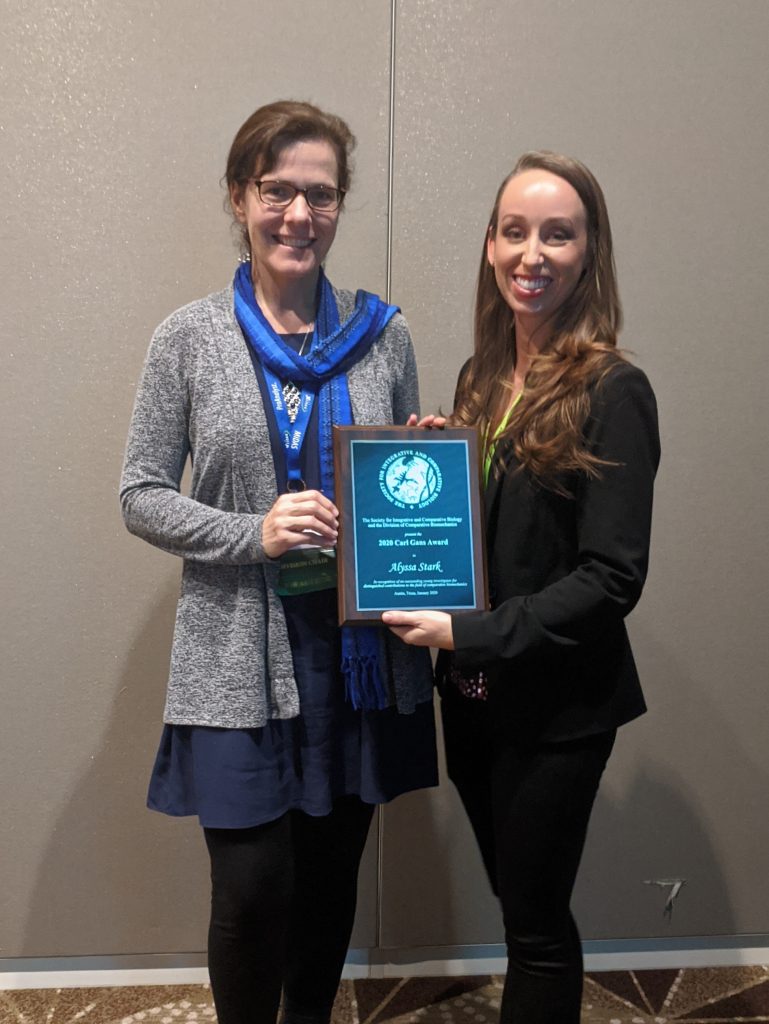
Election for new DCB Chair. This year, we will elect a new Chair-Elect of the Division of Comparative Biomechanics, who will serve as Chair-Elect from 2020-2022 and as Chair of DCB from 2022-2024. Please take the time to read about your colleagues – Marguerite Butler, Brooke Flammang, and James Liao (who have offered to serve in this role) and cast your votes. We especially encourage student and post-doc members to vote — start shaping the future of your society now! Note that you do NOT need to have already paid your 2020 dues to vote — having attended the 2020 meeting in Austin (or being a member in 2019) qualifies you to vote in the spring 2020 elections. We would also like to extend our thanks to Marianne Porter, Andrew Clark, and Eric Tytell for serving on the Nominating Committee for this position.
Future symposium on Mechanical Design of Organisms in honor of Steven Wainwright. At the members’ meeting in Austin, DCB members shared memories of one of the founders of our field, Steven Wainwright, who passed away last year. Steven Wainwright participated in the first session on the topic of biomechanics ever held at a SICB (at that time called American Society of Zoologists) meeting in 1984. Several DCB members have proposed the idea of holding a forward-looking symposium focused on mechanical design in organisms at an upcoming SICB meeting, in honor of Steven Wainwright’s contributions in this area. If you have any ideas to share, or would like to help with planning or organization of this symposium, please contact the DCB Program Officer at dpo.dcb@sicb.org.
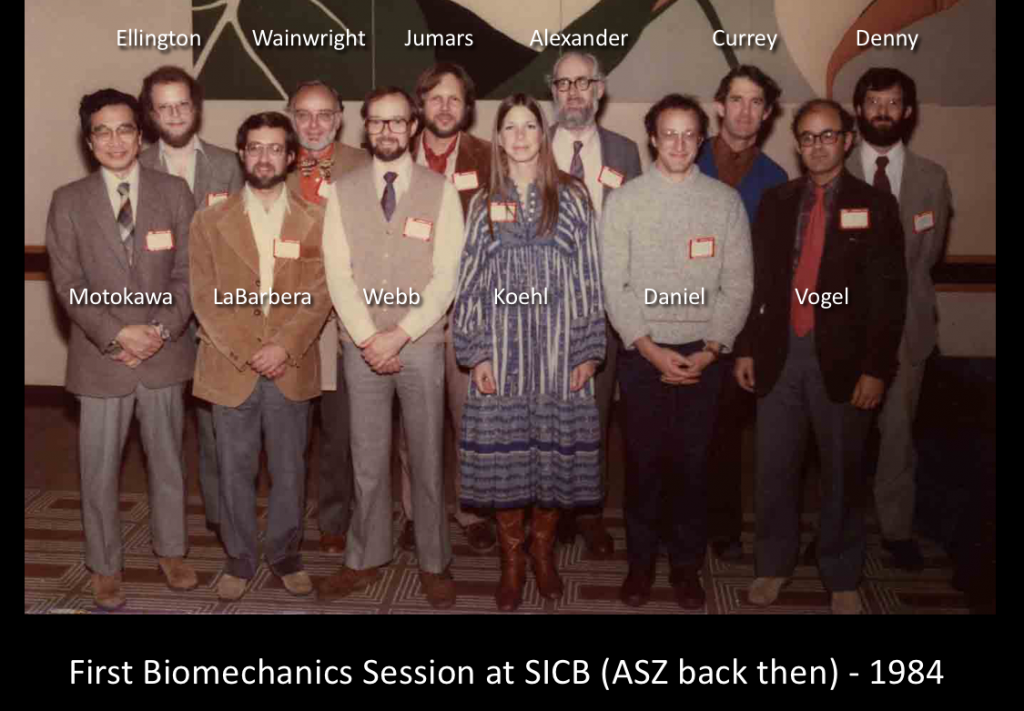
Please send your feedback about changes to the DCB social and Gans Award talk! At this year’s meeting in Austin, we made two changes to our typical programming, and we would love to hear the opinions of DCB members about these changes. First, after a number of years of holding the DCB/DVM socials at off-site locations, the leadership of these two divisions decided that for the time being we needed to switch to holding our joint social on-site. A number of factors led to this decision, including the high cost of off-site socials for the number of people involved, past safety issues for our members when sites can’t be reserved for exclusive SICB use, and the difficulty of arranging for quieter spaces where members can hold conversations (in addition to the music/dancing that many members enjoy). Our primary goal is to provide an event that serves the needs of as many DCB members as possible, whether they enjoy catching up and dancing with old friends, meeting new colleagues, or networking and navigating their first time at the meeting. We are considering organizing off-site socials for upcoming meetings in cases where there is an affordable, interesting site nearby (such as an aquarium, zoo, museum etc.) — but otherwise we plan to hold the socials at the meeting venue in future years.
In addition, for the first time this year we arranged for the Gans Award winner (Alyssa Stark) to deliver a 30-minute keynote talk about her work at the end of the DCB BSP session, when she was presented with her award. The goal of this change was to increase the visibility of the Gans Award for members of DCB, by presenting the award and adding a short talk to the BSP session, which is typically well attended – rather than presenting the award at the members’ meeting with no talk by the recipient, as in the past. We have been told by SICB leadership that scheduling an evening plenary (as for the Bartholomew and Bern lectures) is not feasible, so this seemed like the next best alternative for allowing the Gans Award winner to present their work with the fewest DCB-related conflicts. Again, please share your opinions on one or both of the changes discussed above by emailing them to chair.dcb@sicb.org.
Message from the Program Officer, Matt McHenry, DPO.DCB@sicb.org
I hope that you did not miss the Austin meeting because it was fantastic for our DCB members. SICB 2020 kicked off with one of the all-time great plenary talks by our own Sheila Patek. This was followed by 34 sessions of DCB/DVM talks, numerous poster sessions, 7 biomechanics-related symposia, a wonderful student-paper competition, a trivia-quiz enhanced divisional meeting, and a social that pleased fans of both loud music and a quieter place to talk. Our society and division are attracting a greater diversity of young people and the meeting was buzzing with energy. I spoke with many who left the meeting feeling inspired and recharged. Here is my summary of what happened in Austin and what we can look forward to in future meetings.
Symposia. Symposia are vital to the division and the society in general. They serve to highlight major themes in our field, provide perspectives from outside the society, and serve as a basis for influential published volumes of ICB. Through a strong history of divisional leadership, we are on a streak of supporting excellent symposia. The symposia that we sponsored with DVM in Austin comprised more than half of those presented at the meeting. The talks covered an impressive diversity of topics, including the hydrodynamics of aquatic plants, the silent flight of owls, the evolution of shark teeth, and the role of organismal function in conservation biology.
We are on track to continue supporting diverse and interesting symposia at the upcoming meeting in DC. Here are the topics that DCB and DVM are sponsoring for SICB 2021:
- An Evolutionary Tail: Evo-Devo, Structure, and Function of Post-Anal Appendages. Janneke Schwaner, Tonia Hsieh, Craig McGowan
- Biology Beyond the Classroom: Experiential Learning through Authentic Research, Design, and Community Engagement. Ali Hansen, Lisa Whitenack, Patrice Connors, Hayley Lanier
- Bridging Disciplinary Gaps to Advance Canine Science. Caleb Bryce, Ana Jimenez
- Metachronal Coordination of Multiple Appendages for Swimming and Pumping. Margaret Byron, David Murphy, Arvind Santhanakrishnan
- Physical Mechanisms of Behavior. Patrick Green, Alejandro Rico-Guevara
- The Biology of Sticky: Adhesive Silk, Fiber, and Glue Biomaterials Across Eukaryota. Mercedes Burns, Sarah Stellwagen
Maintaining strong DCB symposia depends on the creative energy of our members. As a former organizer myself, I can say that it is highly rewarding to gather a group of speakers whom you admire and to later see that work in a published volume of ICB. So, please consider organizing a symposium for SICB 2022 in Phoenix, AZ. The deadline for a symposium proposal will be in August, though you will want to start planning soon. If you have some potential ideas, then do not hesitate to contact me with your thoughts (dpo.dcb@sicb.org). Here are some guidelines for what’s involved when organizing a symposium: https://tinyurl.com/tkudwnr
Once SICB members have submitted their symposium ideas, then I will be involved with deciding which ones to approve and grant DCB support. Please help guide me through this process by taking about one minute to fill out the following survey, which indicates the kind of symposium that you would like to attend or maybe organize yourself: https://forms.gle/WYgWamNE9ACLrfBL6
Contributed presentations. It would not be an overstatement to say that biomechanics is kind of a big deal at SICB meetings and this is largely due to the number of contributed presentations. We typically contribute more than one-fifth of the almost 2000 presentations at the annual meetings. The large numbers offer an embarrassment of riches for those of us who enjoy a variety of topics related to biomechanics. Nonetheless, I think we still have room for growth and I would therefore recommend that we all encourage abstract submission by biologists and engineers who have either gotten out of the habit of attending or would enjoy an introduction to our community. I would especially urge people who can drive to the DC meeting to consider submitting an abstract this summer.
You can help yourself get assigned to a session with speakers who share your interests. When you submit an abstract for the DC meeting, select your primary topic under the general subject of Category B: ‘Morphology and Biomechanics’. Presentations under that classification should cross my desk when we put the program together.
Finally, I have to offer my immense gratitude to Phil Anderson and Mason Dean for all of their hard work as Program Officers for DCB and DVM, respectively. Not only did they put together a great program for the Austin meeting, but they also wrote up a mini manual for me and future POs to learn the ropes. Many thanks especially to Phil for getting me up to speed even after wrapping up his successful tenure in this position.
Message from the Secretary, Emily Kane Secretary.DCB@sicb.org
Thanks to Sandy Kawano for her dedication and incredible work serving DCB as Secretary! Her hard work not only means I have large shoes to fill, but also that the transition has been very easy. As Sandy has done, I look forward to continuing to serve the Division as a liaison between members and the Society. Please reach out if you have questions, would like information, or have an opportunity you would like to share with our members!
First, I would like to provide some updates and reminders related to DCB:
DCB Chair-elect election. Our next election will be for the position of DCB Chair-elect, which will serve as chair-elect from 2021-2022, then chair from 2023-2024. You can find our three candidates’ biographies at the end of the newsletter. Thank you to each candidate for being willing to serve our Division!
DCB Researcher’s Database. Let us help you increase the exposure of your lab and submit a contribution to the DCB researcher’s database! For ideas of what to include or to learn more about the work our members do, check out our current database (here). To submit a new contribution (or update an existing contribution), email me at Secretary.DCB@sicb.org and include the following:
- A photo or figure of your research (maximum width = 700 pixels)
- A brief title that describes your research program and / or the submitted photo
- A caption or description to accompany your photo
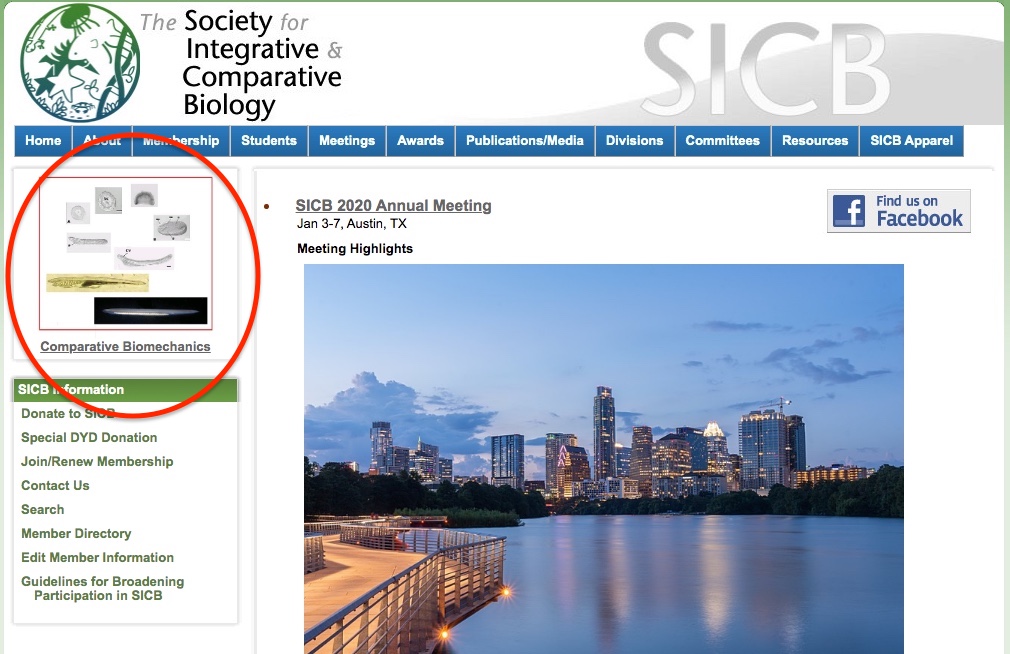
Research and Education Resources. Have you developed lab or course materials related to Biomechanics? Do you have a published dataset that is amenable for use in undergraduate student projects? Do you have cool videos of animals doing incredible things that instructors can use? If so, please consider contributing material to SICB’s Research and Education Resources! This can be a valuable resource for new professors developing their courses (I speak from experience!), for experienced professors looking to refresh their material, or for students looking for ideas for projects or wanting to learn new techniques. Our community is incredibly supportive and has already contributed materials to this database, so let’s keep paying it forward! To submit your materials, go to http://www.sicb.org/rer/ and click ‘Submit’.
There are also lots of great things happening outside if DCB! Here are some upcoming opportunities that you or your students may be interested in.
Journal of Experimental Biology preLights. JEB preLights is looking for contributors! This is a great opportunity for PhD students, postdocs, and pre-tenure faculty to gain exposure and professional experience in science communication. Applications are due by March 20, 2020. For more information, and to apply, see their website or contact prelights@biologists.com.
National Biomechanics Day. National Biomechanics Day is a world-wide celebration of all things Biomechanics for high school students and teachers. This is a great opportunity to showcase comparative biomechanics as a fun and engaging field of study and a potential career pathway for students. The official date is April 8, 2020, but events can be held any spring or early summer day that works best for you. If you plan on hosting an event, you are asked to register your lab, which can be done here. If you do host or participate in an event, let DCB know! We love to highlight our members!
Steven Vogel Young Investigator Award. The Bioinspiration & Biomimetics journal began the Steve Vogel Young Investigator Award in 2017 to recognize the contributions of early career researchers (within 10 years of PhD) in the fields of biomechanics and biomimetics. Consider nominating colleagues (self-nominations are excluded), especially those who have not yet received this type of recognition for their work. The deadline for nominations this year is May 31, 2020. Congratulations to our own Dr. Brooke Flammang who won this award in 2019!
Message from the Student and Postdoctoral Representative, Armita Manafzadeh
Thank you to everyone for making the 2020 annual meeting in Austin such a great success! And thanks especially to everyone who attended the 2020 SPDAC workshop on “Transitions in Science” and/or swung by the SPDAC booth. At the 2021 meeting, we’re looking forward to hosting a SPDAC workshop on “Transferable Skills in Academia and Non-Academia.”
I’m very excited to begin my term serving DCB as the Student and Postdoctoral Affairs Representative! I’d like to take this opportunity on behalf of the student and postdoc members of DCB to thank outgoing representative Brett Aiello for all of his excellent efforts in our division (and for retweeting some really awesome science on the @SICB_DCB_DVM Twitter account) since his appointment in 2017. To briefly introduce myself — my research aims to test paleontological assumptions about articular function in extinct animals using data from the joints of extant animals. Currently, I’m in my fourth year as a PhD candidate in Steve Gatesy’s lab at Brown University, where I’m conducting XROMM analyses of archosaurian hindlimb joints, and developing some new methods for studying in vivo articular function along the way. Let me know if you want to chat about joints!
As the DCB Student and Postdoctoral Affairs Representative, my role is to serve as (1) a liaison between the student and postdoctoral members of our division and the division leadership, and (2) an advocate for the amazing research you’re all doing. So students and postdocs, please feel free to contact me by email (armita@brown.edu) or Twitter (@armanafzadeh) with your suggestions, comments, concerns, or SICB-related feedback, and I’ll be happy to pass them along to Stacy, Matt, and Emily. And everyone, please tag @SICB_DCB_DVM in any tweets you’d like me to signal boost! I’d also love to start highlighting some of your work in more detail, so if you’re a student or postdoc member and you’d like to be featured on the @SICB_DCB_DVM account to share your research with a larger audience, please let me know.
Again, always feel free to reach out to me (armita@brown.edu) — wishing you all a productive Spring and Summer!
DCB Chair-Elect Candidate Biographies
(Ballot: http://burkclients.com/sicb/elections/2020.php)
Marguerite Butler
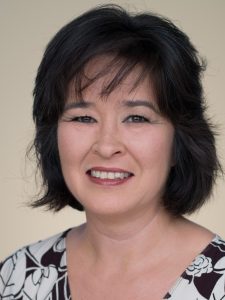
Current Position: Professor, University of Hawaii at Manoa
Education: Postdoctoral Fellow. University of California, Berkeley (2000-2002), Institute for Statistical Mathematics, Tokyo (1998-2000); Ph.D. Evolution and Population Biology. Washington University, St. Louis (1991-1998); M.S. Microbiology (1989-1991), B.S. Interdisciplinary Science (Physics, Biology, Mathematics; 1985-1998), Rensselaer Polytechnic Institute, Troy, NY
Professional Experience: Assistant (2006-2010) and Associate (2010-2018) Professor, University of Hawaii; Assistant Professor (2004-2006) and Research Assistant Professor (2002-2003), University of Tennessee, Knoxville
SICB Activities: Member, Student Support Committee (2006-2007), Participant, Symposium on Ecological Dimorphisms (2007), Participant, Mini-symposium in Honor of Marvalee Wake (2004), Associate Editor of Integrative Organismal Biology (2018-), Member-At-Large (2020-)
Other Memberships: Society for Experimental Biology, American Society of Naturalists, Society for the Study of Evolution, International Society of Vertebrate Morphology, American Association for the Advancement of Science
Research Interests: The Butler lab studies animal performance in the context of biodiversity. We seek to bridge physiological and evolutionary approaches to gain a better understanding of how life evolves. Two current projects include the contribution of performance to diversification in a large group of Papuan microhylid frogs (300+ species), which have evolved jumping, swimming, climbing, and burrowing forms; and visual system specialization in the exploitation of light microhabitats in an adaptive radiation of Hawaiian damselflies. See http://butlerlab.org for more information.
Goals statement: As someone who started her career in evolutionary biology, I have always been grateful for the warm reception, mentoring, and collaboration that Iʻve received from the many generous members of DCB that have enabled me to expand my approaches. I wholeheartedly support DCBʻs commitment to nurturing young scientists and promoting interdisciplinary science, goals which have resulted in a vibrant scientific society. As a former faculty senate chair at UH Manoa I saw firsthand the importance of inclusive leadership and forward-thinking faculty in service roles. I would like to continue efforts to build mentoring networks and promoting smaller-scale social interactions as DCB grows larger, both of which are especially important for our younger and newer colleagues and encourages our exciting cross-disciplinary science as well. At recent meetings, I have realized that many of us are without close colleagues at our home institutions and may benefit from mid-career mentoring. I would like to hear your thoughts on ways that DCB might increase support to careers at all stages. I love DCBʻs efforts to promote forward-looking symposia and bridge to other divisions of SICB and fields beyond, and its dedication to collegiality. I am eager to help support DCB in any way I can.
Brooke Flammang
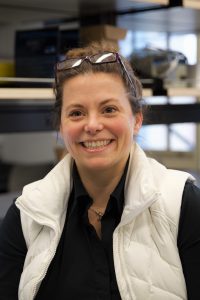
Current Position: Assistant Professor, Federated Department of Biological Sciences, New Jersey Institute of Technology/Rutgers University
Education: PhD, Harvard University, 2010
Professional Experience: Associate of Ichthyology, Museum of Comparative Zoology, Harvard University, 2014 to present; Faculty Seminar Associate, Columbia University, 2014 to present; Board of Freshman Advisors, Harvard College, 2011-2013; Postdoctoral Researcher, Harvard University, 2010-2014; Faculty, Harvard Extension School, Division of Continuing Education, Harvard University, 2009-2014; Editorial Board, Bioinspiration and Biomimetics, 2020-2021; Associate Editor, Royal Society Open Science, 2018-present; Assistant Editor, Integrative and Comparative Biology, 2019-2024; Editorial Advisory Board, Zoology, 2015-2019
SICB Activities: Program Officer, Division of Vertebrate Morphology, 2017-2019; Workshop co-Organizer, “Parenting Through Academia”, 2020; Symposium co-Organizer, “Bioinspiration: Applying mechanical design to experimental biology”, 2011; active member since 2005
Other Memberships: Secretary, International Society for Vertebrate Morphology, 2019-2022; Adhesion Society, American Association for the Advancement of Science, American Physical Society
Research Interests: I am primarily interested in the physics underlying organismal performance and the evolution of morphology. My students’ and my work integrates functional morphology, comparative biomechanics, fluid dynamics, and bioinspired robotics to better understand locomotor mechanics amongst the tremendous diversity of fishes. In short, we are interested in the different ways that organisms swim, walk, and stick in place to go nowhere at all, the physics that constrain performance and selection for unique morphologies, and the fundamental properties of biomechanics that hold true for all organisms.
Goals Statement: Comparative Biomechanics is by default an integrative science. Success in integrative biology relies upon robust collaborative endeavors among diverse thinkers – exactly the environment that I feel is fostered and continues to grow strong within SICB. If chosen as DCB Chair-elect, it is my goal to foster a welcoming environment within our membership at all ranks, which I believe will ultimately lead to the greatest science our rapidly growing division can offer. I would like to work towards increasing opportunities and recognition for our early-career researchers, particularly through emphasizing the Steven Vogel Grant in Aid of Research and through the Best Student Talk and Poster awards. I was thrilled to see that the Gans Award included a plenary address this year, and I support the continued elevation of this prestigious honor. I have worked towards promoting equal opportunity and treatment within SICB through advising on parenting resources and being a Code of Conduct Ally. As Chair-elect I bring the same intentions for an environment of inclusivity and diversity within DCB in both the professional and social aspects of our meeting.
James C. Liao
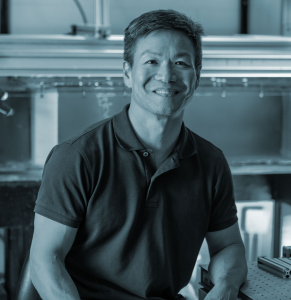
Current Position: Associate Professor of Biology and University Term Professor, University of Florida/The Whitney Laboratory for Marine Bioscience. Affiliate Professor, J. Crayton Pruitt Family of Biomedical Engineering.
Education: Ph.D. Biology, Harvard University (2004), M.A. Biology, Harvard University (2003), B.A. Biology magna cum laude, Wesleyan University (1996).
Professional Experience: Assistant/Associate Professor of Biology and Affiliate Professor, J. Crayton Pruitt Family of Biomedical Engineering, University of Florida/The Whitney Laboratory for Marine Bioscience (2009-present); Instructor, Neurophysics of Sensory Navigation, Santa Barbara Advanced School of Quantitative Biology/ Kavli Institute for Theoretical Physics (summer 2018); Research Associate, Division of Vertebrate Zoology, American Museum of Natural History (2011-2014); Affiliate Assistant Curator of Ichthyology, Florida Museum of Natural History (2009-present); Research Associate, Department of Neurobiology, Cornell University (2007-2008); NIH NRSA Postdoctoral Fellow, Cornell University (2004-2007); Visiting Research Faculty, Undergraduate and Graduate Tropical Field Biology, Organization for Tropical Studies (2000-present).
SICB Activities: Member of DVM since 1998. Judge, student awards in Divisions of Comparative Biomechanics, Vertebrate Morphology, and Neurobiology (2005-2014). Public Affairs Committee (2017-2020).
Other Memberships: Association for Research in Otolaryngology; Society for Neuroscience; International Society for Neuroethology; Society for Experimental Biology; American Society of Ichthyologists and Herpetologists.
Research Interests: My lab is interested in the mechanisms of vertebrate behavior. I look through the lens of biomechanics and neuroscience to better understand fish behavior across multiple levels of biological organization, from single neurons to the whole organism. Our approaches include using optogenetic and electrophysiological approaches in zebrafish to understand the neural circuits underlying sensorimotor behaviors, and leveraging comparative studies to understand how the environment influences organismal performance. Current work in the lab is focused on understanding the algorithms of predator attack strategies using a closed-loop virtual reality system and improving ways to monitor the movement ecology of fishes in the field with high spatial and temporal resolution. In other words, we try to bring the ocean into our lab as well as bring our lab to the ocean.
Goals Statement: DCB is a gem within SICB, and I’d be honored and excited to expand the goals of this division by attracting and retaining scientists from non-traditional backgrounds and bringing in creative ways to communicate more broadly with society. I would like to build on my science communication and storytelling experiences with the SICB Public Affairs Committee to develop skills needed to convey our messages powerfully to the public. Similar to the workshop I organized “Persuasive Communication: When Acting Meets Science,” I envision establishing a permanent program that brings in performance artists (improvisation and theater instructors, public speakers, etc.) to help improve the effectiveness of our communication. I also think it is important to provide more effective social opportunities so that scientists at all career stages have the opportunity to interact. This would establish rapport early on with leaders in the field and provide perspective and strategic insight to early career scientists.
